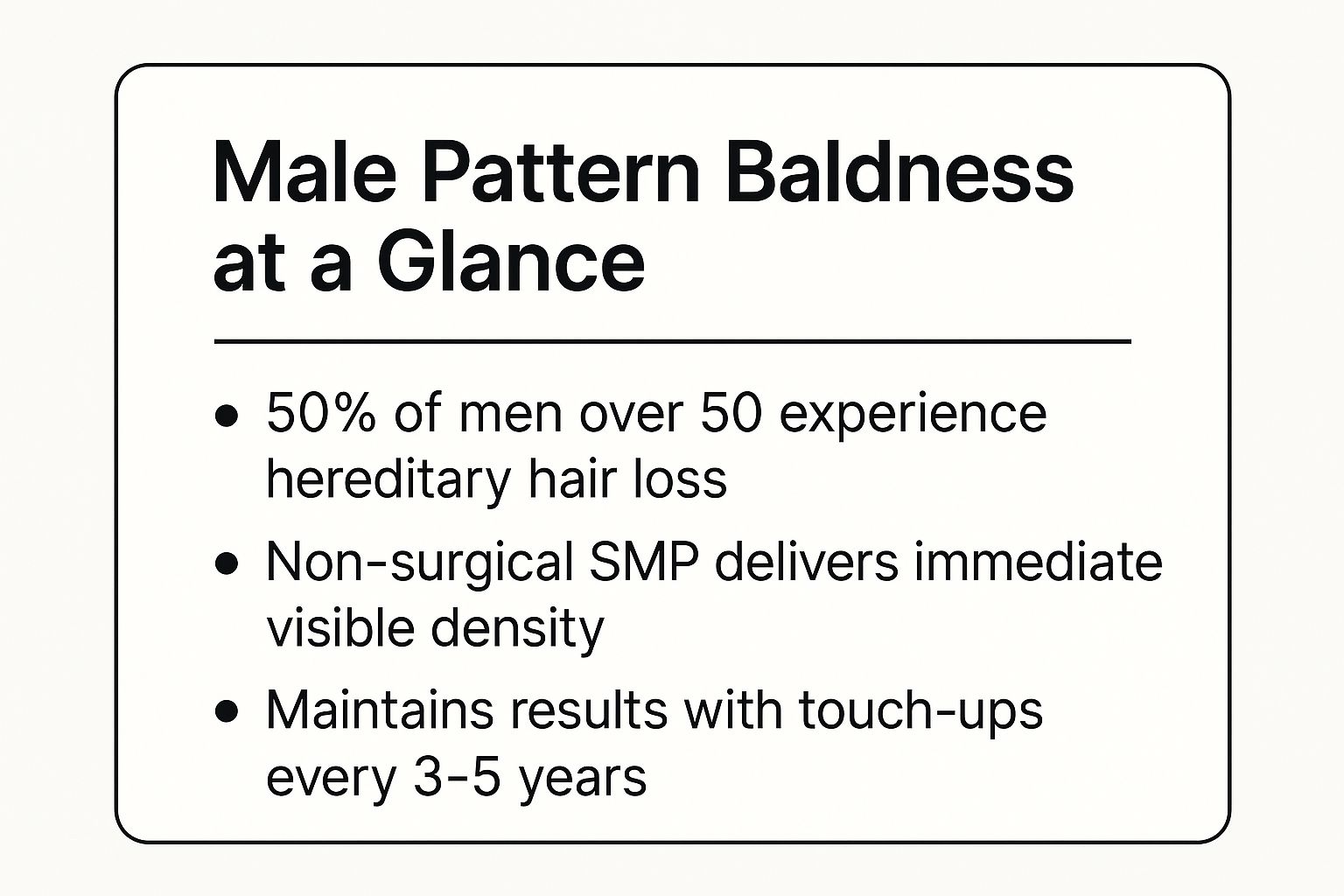
Who Can Benefit From Hair Tattoos? Top 6 Groups in 2025
Share
Hair loss doesn't discriminate, affecting people from all walks of life for a multitude of reasons. While solutions like transplants and topical treatments exist, a highly effective and increasingly popular option is transforming lives: the hair tattoo, professionally known as Scalp Micropigmentation (SMP). This innovative technique, however, is not just for creating the look of a sharp buzz cut. It’s a versatile tool that offers hope and renewed confidence to a surprisingly diverse range of individuals struggling with various forms of hair loss.
This comprehensive guide is designed to explore exactly who can benefit from hair tattoos. We will move beyond common assumptions to reveal how SMP provides tailored, life-changing solutions for different needs. Our list will detail specific scenarios, from genetic thinning and medical-related hair loss to the concealment of scars, offering practical insights into how this procedure works for each case.
If you're exploring ways to manage hair loss, you might be surprised to find your situation perfectly suited for this remarkable treatment. We will break down the distinct advantages for men with pattern baldness, women experiencing thinning, alopecia sufferers, and even hair transplant patients seeking to enhance their results. Let's uncover how this procedure can help you reclaim your look.
1. Men with Male Pattern Baldness
Men experiencing androgenetic alopecia, more commonly known as male pattern baldness, are prime candidates who can benefit from hair tattoos. This genetic condition is incredibly common, causing a predictable pattern of hair loss that often starts with a receding hairline and thinning at the crown. For many, this gradual hair loss can significantly impact self-confidence.
Scalp micropigmentation (SMP) offers a powerful, non-surgical solution by meticulously tattooing thousands of tiny, layered dots onto the scalp. These dots replicate the appearance of individual hair follicles, creating the illusion of a full, closely shaved or "buzzed" head of hair. Unlike hair transplants, which require donor hair and lengthy recovery, SMP provides immediate, visible results that restore the hairline and add density to thinning areas.
Who It’s For: Real-World Examples
This solution is particularly effective for a wide range of individuals seeking a low-maintenance and modern aesthetic.
- Professionals and Executives: Men in corporate environments, like tech executives, often choose SMP to maintain a sharp, polished, and youthful appearance without the downtime associated with surgery.
- Athletes and Active Men: Those with active lifestyles benefit from the sheer convenience of SMP. There’s no need to worry about topical concealers sweating off or special maintenance routines.
- Men with Early-Stage Thinning: Individuals in their 30s, 40s, or 50s who are just beginning to see significant thinning can use SMP to add density and camouflage scalp visibility, effectively turning back the clock on their hair loss.
The following summary box offers a quick glance at the key aspects of male pattern baldness and SMP as a solution.

As the data shows, SMP provides a lasting and immediate answer for a condition that affects a vast percentage of the male population.
Actionable Tips for Optimal Results
To get the most out of your treatment, consider these practical steps:
- Choose the Right Shade: Opt for a pigment shade slightly lighter than your natural hair colour. This allows for a softer, more natural blend and prevents the treatment from looking too harsh or dark over time.
- Act Sooner Rather Than Later: While SMP is effective on fully bald heads, starting treatment during the earlier stages of hair loss allows the practitioner to blend the pigment seamlessly with your existing hair.
- Maintain Your Look: To ensure the tattooed follicles look realistic, you must regularly shave your head. This keeps any remaining hair at the same length as the SMP dots, creating a uniform and undetectable finish.
- Research Your Practitioner: Look for a specialist with extensive experience in treating male pattern baldness. Their portfolio should showcase natural-looking hairlines and skillful blending.
Ultimately, for those wanting to understand the root cause of their hair loss, you can learn more about why men suffer from male pattern hair loss to make a fully informed decision.
2. Cancer Survivors and Chemotherapy Patients
Cancer patients undergoing chemotherapy often experience significant hair loss, a condition known as chemotherapy-induced alopecia. This sudden and often complete loss of hair can be a deeply distressing side effect, impacting a person's sense of self and psychological well-being during an already challenging time. Hair tattoos, or scalp micropigmentation, offer an empowering and restorative solution for these individuals.
By replicating the appearance of natural hair follicles, SMP creates the look of a full head of hair that has been closely shaved. This non-invasive procedure helps cancer survivors regain a sense of normalcy and control over their appearance, providing a much-needed confidence boost during and after their treatment journey. It's a way to restore their pre-illness look without relying on wigs or hats, which some find uncomfortable or inconvenient.
Who It’s For: Real-World Examples
This treatment provides profound psychological and aesthetic benefits for those navigating the aftermath of cancer treatment.
- Breast Cancer Survivors: Women returning to the workplace after treatment often use SMP to create a stylish, low-maintenance buzz-cut look, helping them feel confident and professional.
- Leukaemia Patients: Individuals who have undergone extensive treatment can use SMP to maintain their appearance, allowing them to participate in social activities without feeling self-conscious about their hair loss.
- Paediatric Cancer Survivors: For young survivors, SMP can be life-changing, helping them build confidence and feel more like their peers as they navigate school and social development post-treatment.
The following summary box offers a quick glance at the key aspects of chemotherapy-induced hair loss and SMP as a solution.

As the statistics indicate, addressing the visible side effects of cancer treatment is a critical component of holistic recovery.
Actionable Tips for Optimal Results
To ensure a safe and effective treatment, survivors should follow these important steps:
- Wait for Medical Clearance: It is crucial to wait at least 3-6 months after completing chemotherapy before undergoing SMP. This allows your immune system to recover and your skin to return to a healthier state.
- Choose a Specialist in Medical Cases: Seek a practitioner who has specific experience working with cancer survivors. They will understand the unique sensitivities of post-chemotherapy skin and how to achieve the most natural-looking results.
- Consider Gradual Sessions: The skin can be more sensitive after treatment. Breaking the procedure into several shorter sessions allows the skin to adjust and heal properly between appointments, ensuring a more comfortable experience.
- Coordinate with Your Medical Team: Always consult with your oncologist or medical team before starting SMP. They can provide clearance and ensure the treatment is safe for you based on your individual health circumstances.
3. Individuals with Alopecia Areata
People diagnosed with alopecia areata, an autoimmune condition that causes unpredictable and patchy hair loss, are excellent candidates who can benefit from hair tattoos. This condition occurs when the immune system mistakenly attacks hair follicles, leading to circular bald patches that can appear anywhere on the scalp. The erratic and often recurring nature of alopecia makes long-term solutions challenging, causing significant emotional distress for many.
Scalp micropigmentation (SMP) provides a consistent and reliable cosmetic remedy. By applying specialised pigment to the scalp, a practitioner can expertly conceal the bald patches, blending them seamlessly with the existing hair. This technique can be used to add the appearance of density to thinning areas or to create a full, buzzed-head look if hair loss is extensive. Unlike other treatments that may not work or can have side effects, SMP offers immediate visual improvement and restores a sense of control.
Who It’s For: Real-World Examples
This solution is particularly transformative for those whose lives are affected by the unpredictability of alopecia areata, offering stability in their appearance.
- Teachers and Public Speakers: Professionals who are constantly in the public eye can regain confidence knowing their hair loss is concealed, allowing them to focus on their work without self-consciousness.
- Young Adults: University students or individuals starting their careers often find the sudden onset of alopecia distressing. SMP offers a modern, stylish solution that helps them navigate these crucial life stages with greater confidence.
- Parents: Many parents choose SMP to maintain a consistent appearance for their young children, who may find the visible changes from alopecia confusing or unsettling.
Actionable Tips for Optimal Results
To ensure the best outcome when addressing alopecia areata with SMP, consider these practical steps:
- Find an Alopecia Specialist: Work with a practitioner who has proven experience with alopecia clients. They will understand the unique challenges, such as blending with existing hair and working on sensitive skin.
- Plan for Future Changes: Discuss a flexible treatment plan with your practitioner. Since alopecia patterns can shift, a modular approach allows for easier touch-ups or additions if new patches appear.
- Document Your Hair Loss: Take clear photos of your scalp before beginning treatment. This provides a valuable reference for your practitioner to ensure the most accurate and natural-looking application.
- Prepare for a Full Head Treatment: Even if you only have a few patches, be mentally and financially prepared for the possibility of treating the entire scalp in the future if the condition progresses.
Ultimately, SMP empowers those with alopecia by offering a stable solution in an unstable condition. You can explore a detailed guide to scalp micropigmentation for alopecia to understand how this procedure is tailored for this specific condition.
4. Women with Female Pattern Hair Loss
Female pattern hair loss, also known as androgenetic alopecia, is a condition that affects up to 40% of women by the age of 50. Unlike male pattern baldness, it typically presents as diffuse thinning across the crown and top of the head, rather than a receding hairline or complete baldness. For many women, this change in hair density can be emotionally distressing and impact self-esteem.
Scalp micropigmentation offers a discreet and effective solution by reducing the contrast between the hair and the visible scalp. By carefully applying pigment in tiny dots between existing hair strands, practitioners create an illusion of greater density and fullness. This technique darkens the scalp, making thinning areas much less noticeable and helping to restore a more youthful and voluminous appearance to the hair. It's an ideal camouflage for women who can benefit from hair tattoos without wanting a shaved look.

Who It’s For: Real-World Examples
This solution is tailored for women who wish to maintain their existing hair length while camouflaging areas of thinning to regain confidence.
- Professional Women: Women in corporate or client-facing roles often choose SMP to maintain a polished, confident appearance, ensuring their hair looks full and healthy without daily concealers.
- Mothers Experiencing Postpartum Hair Loss: New mothers dealing with temporary but significant shedding (telogen effluvium) can use SMP to bridge the gap while their hair recovers its natural density.
- Women Over 40 with Hereditary Thinning: Those with a genetic predisposition to thinning can use SMP to effectively manage and conceal the progressive loss of volume, particularly along their part line and at the crown.
Actionable Tips for Optimal Results
To ensure the most natural-looking and effective outcome from your SMP treatment, consider the following advice:
- Seek a Specialist: It is crucial to find a practitioner who specialises in treating female hair loss. They will have the experience needed to work with long hair and create a soft, natural densification effect.
- Bring Reference Photos: Come to your consultation with photos showing your desired level of coverage or how your hair looked before significant thinning. This helps the practitioner understand your aesthetic goals.
- Test Part Positions: Before your treatment, experiment with different hair parts (centre, side, off-centre). This will help you and your practitioner decide where to focus the density treatment for the most impact on your daily look.
- Time Your Treatment: Consider scheduling your sessions around your hair styling routine. Arrive with clean, dry hair styled as you normally would so the technician can see precisely where the thinning is most visible.
Ultimately, SMP is a powerful tool for restoring the appearance of hair density. You can learn more about how SMP is used to treat women's hair loss to make a fully informed decision about your hair restoration journey.
5. Hair Transplant Patients Seeking Enhancement
Individuals who have undergone hair transplant surgery often turn to scalp micropigmentation to perfect their results. While a transplant can restore growing hair, it sometimes falls short of creating the desired density or may leave visible scars, particularly in the donor area. This is where hair tattoos serve as an exceptional complementary procedure.
Scalp micropigmentation (SMP) expertly fills in the gaps between transplanted hairs, creating an illusion of greater thickness and fullness. By depositing pigment that mimics natural hair follicles, SMP camouflages scars from both FUT (strip surgery) and FUE (follicular unit extraction) procedures. This combination approach allows patients to achieve a more complete and natural-looking hair restoration, maximising the visual impact of their surgical investment.
Who It’s For: Real-World Examples
This two-step solution is ideal for a variety of post-transplant scenarios, refining and completing the hair restoration journey.
- Patients with Insufficient Donor Hair: Those who lack enough donor follicles for full coverage can use SMP to add visual density across the scalp, making the transplanted hair appear much thicker.
- Athletes and Individuals with FUE Scarring: FUE surgery can leave numerous small, dot-like scars in the donor area. SMP is highly effective at concealing this scarring, allowing individuals to wear their hair short without revealing signs of the procedure.
- Individuals with Unsatisfactory Transplant Results: If a transplant yields a lower-than-expected density or an unnatural-looking hairline, SMP can correct these issues by adding fullness and refining the hairline shape for a better outcome.
Actionable Tips for Optimal Results
To ensure the best synergy between your hair transplant and SMP, consider these key steps:
- Wait for Full Healing: It is crucial to allow your scalp to heal completely before undergoing SMP. Most practitioners recommend waiting at least 6-12 months after your hair transplant surgery.
- Choose a Post-Transplant Specialist: Seek an SMP artist with specific experience working on post-transplant clients. They will understand how to work with scar tissue and blend pigment seamlessly with transplanted hair.
- Bring Documentation: Provide your SMP practitioner with photos from before and after your transplant. This helps them understand your original hair loss pattern and design a treatment that complements the hair growth.
- Explore Complementary Therapies: Beyond hair tattoos, many individuals, including hair transplant patients, explore other advanced aesthetic solutions like PRP treatments to enhance hair density and stimulate growth.
Ultimately, combining these two powerful treatments can deliver the comprehensive results many are looking for. You can discover how SMP complements hair transplant surgery to make a fully informed decision about your hair restoration path.
6. Individuals with Scarring and Trauma-Related Hair Loss
People with scars on their scalp from accidents, burns, surgical procedures, or other forms of trauma often face permanent hair loss in those areas. Damaged skin and scar tissue prevent hair follicles from regenerating, leaving noticeable patches where hair can no longer grow. This type of hair loss can be a constant and difficult reminder of past trauma, significantly affecting a person's self-image.
Scalp micropigmentation (SMP) serves as a remarkable and effective camouflage technique for these situations. By carefully depositing specialised pigments into the layers of scar tissue and the surrounding scalp, a skilled practitioner can blend the scarred area seamlessly with the rest of the head. The treatment mimics the look of natural hair follicles, drastically reducing the visibility of the scar and creating a uniform, even appearance.
Who It’s For: Real-World Examples
SMP offers a transformative solution for anyone seeking to conceal scalp scars and regain a sense of normalcy and confidence.
- Burn Survivors: Individuals with scalp scarring from burns can use SMP to restore a natural-looking hairline and cover affected areas, helping them move forward from their injuries.
- Accident Victims: Those with scars resulting from head trauma or accidents can effectively conceal discolouration and texture irregularities, making the marks almost undetectable.
- Patients with Surgical Scars: People who have undergone brain surgery, craniotomies, or even older hair transplant procedures often have linear scars that SMP can expertly camouflage.
For many, this procedure is the final step in their physical and emotional recovery journey, providing a clean slate.
Actionable Tips for Optimal Results
To achieve the best possible outcome when covering scar tissue, keep these tips in mind:
- Ensure Scars Are Fully Healed: Your scar must be completely healed and no longer pink or red, which usually takes at least 6-12 months. Treating a scar too early can lead to poor pigment retention and discomfort.
- Seek a Specialist in Scar Camouflage: Working on scar tissue is different from working on healthy skin. Find a practitioner with a proven portfolio of successful scar concealment to ensure they have the necessary expertise.
- Consider Pre-Treatment Options: Treatments like microneedling can help flatten and soften scar tissue before your SMP sessions, which can improve the final result by creating a smoother canvas for the pigment.
- Plan for a Longer Timeline: Scar tissue absorbs pigment differently than normal skin. You may require more sessions than a standard SMP treatment to achieve the desired level of coverage and blending.
Ultimately, SMP provides a powerful way to manage the aesthetic impact of scalp trauma. For those with scarring from previous surgeries, you can learn more about concealing a hair transplant scar to understand the full potential of this solution.
Who Benefits Most from Hair Tattoos: 6-Group Comparison
| Demographic / Use Case | Implementation Complexity 🔄 | Resource Requirements ⚡ | Expected Outcomes 📊 | Ideal Use Cases 💡 | Key Advantages ⭐ |
|---|---|---|---|---|---|
| Men with Male Pattern Baldness | Moderate - standard SMP techniques | Moderate - common treatment | Immediate visible density, natural shaved head look | Men with receding hairlines or crown thinning | Cost-effective, no surgery, boosts confidence |
| Cancer Survivors and Chemotherapy Patients | Higher - sensitive skin, medical clearances | Moderate to High - medical coordination | Immediate aesthetic restoration with psychological benefits | Patients post-chemotherapy, sensitive scalps | Non-invasive, emotional well-being support |
| Individuals with Alopecia Areata | High - unpredictable hair loss patterns | High - frequent adjustments | Consistent coverage despite irregular patches | Autoimmune hair loss, variable hair loss stages | Gender-neutral, suitable for all ages, reduces anxiety |
| Women with Female Pattern Hair Loss | High - subtle, natural blending | High - skilled practitioners | Natural density illusion, works with longer hairstyles | Women with diffuse thinning, maintaining feminine looks | Maintains hairstyle options, subtle enhancement |
| Hair Transplant Patients Seeking Enhancement | Moderate to High - coordination needed | Moderate - multiple sessions | Improved density, scar coverage, seamless blend | Post-transplant patients needing enhancement | Maximizes transplant investment, covers scars |
| Individuals with Scarring and Trauma-Related Hair Loss | High - scar tissue challenges | High - specialized techniques | Covers scars, uniform appearance on damaged scalp | People with trauma or surgical scars | Only viable option for scars, psychological benefit |
Your Path to Renewed Confidence Starts Here
As we’ve explored, the answer to the question "who can benefit from hair tattoos?" is remarkably diverse and inclusive. The power of Scalp Micropigmentation (SMP) extends far beyond a single demographic, offering a sophisticated and effective solution for a wide array of individuals facing different forms of hair loss. We've seen its transformative potential for men grappling with the familiar Norwood scale of male pattern baldness, providing the sharp, clean look of a buzz-cut without surgery.
We’ve also delved into the profound impact SMP has on those whose hair loss journey is tied to medical challenges. For cancer survivors, it’s a way to reclaim a piece of themselves post-chemotherapy. For individuals managing the unpredictable nature of alopecia areata, it offers a stable, consistent appearance that hairpieces or topical treatments often cannot. The same holds true for women experiencing the diffuse thinning characteristic of female pattern hair loss, where SMP expertly creates an illusion of density, restoring volume and camouflaging the scalp.
Moreover, the versatility of this procedure shines when applied to more specialised cases. SMP serves as an exceptional partner to hair transplant surgery, flawlessly concealing FUT and FUE scars while adding density to complement the transplanted follicles. It is also a powerful tool for masking scars from accidents, surgeries, or burns, turning what was once a source of self-consciousness into an unnoticeable part of a natural-looking hairline.
Taking the Next Step on Your Journey
If you recognise your own story in any of these scenarios, it’s a clear sign that SMP could be the solution you’ve been searching for. The journey begins not with a commitment, but with a conversation. Understanding your specific goals, hair loss pattern, and skin type is the crucial first step.
Your action plan should look like this:
- Self-Assessment: Re-read the section that resonates most with you. Consider your desired outcome: Are you aiming for a sharp, shaved-head look, or do you need to add density to existing hair?
- Professional Consultation: The single most important step is to seek expert advice. A skilled SMP practitioner can provide a personalised assessment, show you a portfolio of relevant work, and create a customised treatment plan. They will evaluate your scalp, discuss pigment selection, and design a hairline that perfectly complements your facial structure.
- Ask the Right Questions: Prepare for your consultation. Ask about the artist's experience with cases like yours, their sterilisation practices, and what to expect during and after the procedure.
Ultimately, understanding who can benefit from hair tattoos is about realising that you are not alone and that a viable, lasting solution is within reach. This isn't just about aesthetics; it's about restoring the confidence that hair loss can diminish. It's about looking in the mirror and seeing a reflection that feels authentic and empowered.
Ready to explore how Scalp Micropigmentation can personally benefit you? At My Transformation, Michael specialises in creating hyper-realistic, life-changing results tailored to each client's unique needs. Visit My Transformation to book your complimentary consultation and take the first step towards your renewed confidence today.
